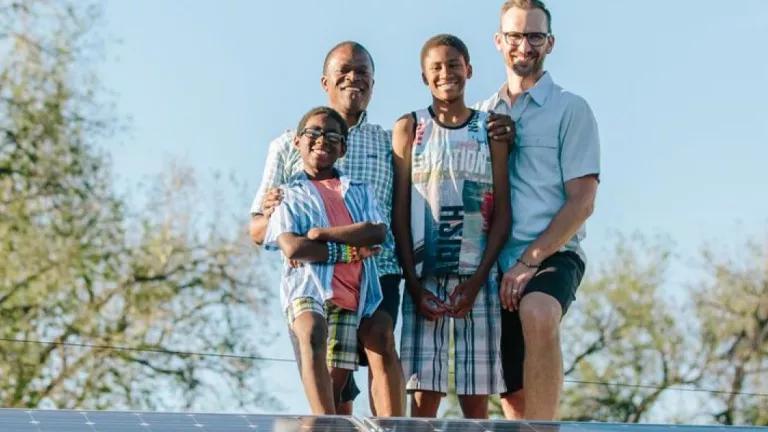An Opportunity for Equitable Climate Finance
NRDC submitted comments to EPA's Environmental Financial Advisory Board on the opportunity the Greenhouse Gas Reduction Fund presents.
Tucked more than 650 pages into the Inflation Reduction Act – and spanning just five pages of legislative text – is one of the law’s most promising tools for scaling equitable climate action: the Greenhouse Gas Reduction Fund (“Fund”).
The $27 billion Fund creates a first-of-its-kind program at the Environmental Protection Agency (EPA) to rapidly deploy low- and zero-emission technologies and projects to parts of our country that have thus far been overlooked in the clean energy transition. The Fund will provide catalytic financial support to nonprofit lenders, states, municipalities, and Tribal Governments for projects that reduce or avoid greenhouse gas (GHG) emissions, with the majority of funds flowing to low-income and marginalized communities.
The Fund builds on the successful track record of existing mission-based financing entities that leverage public and private capital, including community development financial institutions (CDFIs), established state and local green banks, credit unions, and others – and it has the potential to transform US climate finance. But that potential will only be realized if EPA designs and implements the program in a thoughtful, flexible, and equitable way. To create a truly effective financing program, EPA should keep in mind four key principles:
Additionality, Market Creation, and Ecosystem Development
First, EPA should require applicants to demonstrate how use of Fund will:
- Accelerate deployment of key projects and technologies that would otherwise not be pursued;
- Efficiently combine public and private capital to drive new market creation and/or market transformation that results in more equitable outcomes; and
- Support a robust ecosystem of projects that deliver clear and measurable quality-of-life outcomes for communities, in addition to pollution reduction.
EPA should make awards with an eye towards developing an ecosystem for climate finance. That means flexibly allowing awardees to utilize various forms of financial assistance – including recoverable and non-recoverable grants, low- and zero-interest loans, and low-cost, innovative impact investing structures – in order to reach all communities, sectors, and technologies. Awardees should demonstrate how they have and will continue to work alongside communities, supporting and collaborating on project development, investing in workforce and small business development, and measuring and evaluating their progress. Likewise, EPA should empower communities to share in the benefits of deploying clean energy technologies by encouraging community ownership and wealth-building strategies.
Prioritize Low-Income and Marginalized Communities and Households Throughout
EPA has a unique opportunity to deliver meaningful, lasting benefits to communities that have been historically underserved by private markets due to systemic public and private disinvestment and environmental injustices. To ensure that funds reach the people most in need, EPA should apply the Justice40 Initiative’s definition of “disadvantaged communities” and expand it to include other relevant factors (such as energy insecurity, energy burden, vulnerability to climate impacts, and lack of access to credit or capital).
Beyond the $15 billion explicitly earmarked for low-income and marginalized communities, EPA should prioritize applicants that will reach low- and moderate-income households regardless of where they live, as well as small businesses that are based outside of environmental justice communities but still serve them.
Fast, Equitable, Flexible, and Collaborative Deployment
To deploy capital quickly and equitably, the Fund should route a significant share of funding through existing mission-driven institutions, including CDFIs, established green banks, housing finance agencies, public housing authorities, credit unions, and minority depository institutions. Qualified entities should have demonstrated track records of successfully deploying capital in low-income and marginalized communities and a commitment to collaborate with a broad network of partners. The Fund represents a critical opportunity to adapt and leverage the vast existing community and green finance infrastructure throughout the country.
EPA should afford flexibility to established institutions regarding how financing products are designed, how customers are solicited, and how funds are ultimately deployed in GHG-reducing projects and technologies. Flexibility will allow lenders to be market-responsive and serve customers with different needs in different geographies. EPA should also use a smaller tranche of the Fund to invest in and spur new institutions and innovative approaches that address persistent gaps in the marketplace.
Governance and Performance Standards
EPA should select awardees that can credibly demonstrate (1) governance practices that are inclusive of, responsive to, and accountable to low-income and marginalized communities and (2) best practices for nonprofit and financial governance. EPA should also define clear impact standards and metrics for awardees that focus on improvements to the lived experience of marginalized communities, as well as significant emissions reductions.
By designing a program built on these four pillars, EPA can maximize the Fund’s environmental, equity, and economic benefits. With proper design, implementation, and oversight, the agency has a rare opportunity to use this $27 billion investment to dramatically scale and transform climate finance in the United States to both improve lives and fight climate change.




